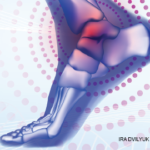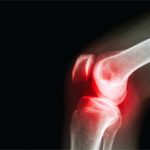Most people pronate excessively. This motion occurs at the subtalar joint, which, because of its important influence on the structures above, I consider the “structural core” of the human body. Besides the foot rolling in and flattening, this triplane motion causes abduction and eversion. These motions result in the foot (our foundation) dislocating from underneath the body. The profound effect this motion has on other joints cannot be overemphasized, and leads me to make a simplistic statement, knowing full well that it is destined for skepticism: The major cause of OA of the weight-bearing joints is excessive pronation at the subtalar joint, which causes abnormal alignment of the knees, hips, and back, resulting in the increased friction that subsequently causes joint deterioration. I advance this proposition understanding that more proximal deformities, like scoliosis, can cause lower extremity problems as well.
To better appreciate the structural issues, stand up and pronate your right foot. Notice how much this pronation (an almost universal problem) causes your knee to internally rotate. Take a few steps around the room and begin to imagine what a destructive force this would have on your knee over the course of a lifetime. If pronation or a flattening of your foot had always been a problem for you, would it be accurate to say that, at age 70 years, the cause of your OA was age, and perhaps excessive weight? Or, would it be more accurate to say that your pathomechanics was the primary cause of your problem, age and weight being important secondary factors? Next, stand in front of a mirror and, while leaning slightly on the outsides of your feet (somewhat supinated), do a few simple squats. You should notice that your knees are tracking straight and not internally rotated. Repeat this maneuver while trying to maximally pronate your feet and you should see and feel the increased tension and stress on the insides of your knees. You will also notice less force/power.
It is important to evaluate the difference in the position of a patient’s feet, knees, and hips on and off weight bearing, because testing in these positions can show the deforming forces caused by the effects of malalignment and gravity and demonstrate how the patient will actually function. As an example of another evaluation, sit in a chair, barefoot and in shorts, with your knees at right angles to your hips and your feet lightly resting on the ground. Supinate your feet slightly (subtalar neutral), so that they are aligned directly under your knees. Now stand up and let your feet assume their normal position. In most instances, some pronation will occur, as seen by a flattening of the feet, accompanied by internal rotation of the knees. I consider that any change in this positioning between sitting (making sure your foot is in subtalar neutral) and full weight bearing is pathological and will cause deterioration of the weight-bearing joints.

